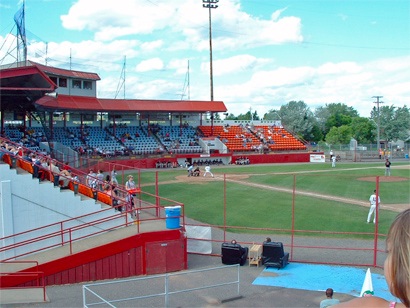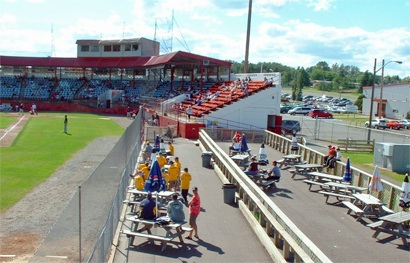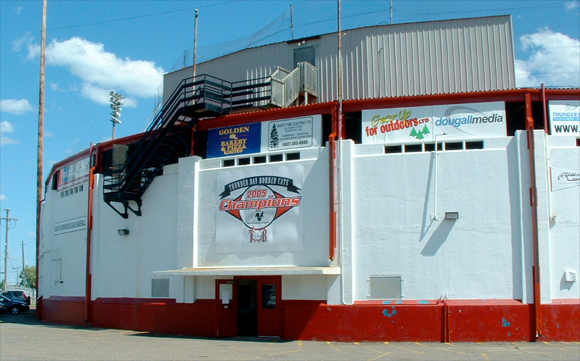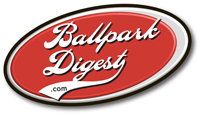There are some ballparks that are just plain likable, in spite of some deficiencies. Port Arthur Stadium, tucked into a corner of Thunder Bay, is one of those places. It’s not a very large facility, and it’s not very fancy. In fact, it’s a pretty basic ballpark and the Thunder Bay Border Cats don’t do a lot of fancy between innings activities. So, if you like your baseball simple and uncomplicated, this is your kind of ballpark and your kind of team.

FAST FACTS
Year Opened: 1951
Cost: $200,000
Capacity: 3,031
Dimensions: 330L, 400C, 330R
Playing Surface: Grass
Website: bordercatsbaseball.com
Phone: 807/766-2287
League: Northwoods League
Parking: Free in lot in front of and adjacent to the ballpark. Insider’s Tip: Park either far down the right field line or by the Canada Games complex. Anywhere else could put you in prime foul ball territory.
Address/Directions: 425 Winnipeg Av., Thunder Bay, ON P7B 6P7. The ballpark is just off Memorial Ave, which is one of the main streets in the city. The easiest way to get to the park is to take Memorial to Lisgar and go west two blocks to the park. It is located in the same complex as the Canada Games and Port Arthur Arena.
Port Arthur Stadium has a classic ballpark design, featuring a main grandstand covered by an awning that came with the place in 1951. One of the tricks to attending a game at Port Arthur is to sit as far up the stands as you can. (The prices are the same no matter where you are in the grandstand.) The higher you go, the better the scenery beyond left field is. The park faces north and, on a clear day, you really can see forever.
Beyond the left-field stands is a series of picturesque mountains (the Sleeping Giant can clearly be seen) and on those clear days you can even catch a glimpse of Lake Superior, which is several miles away.
Originally, there were bleachers down both lines. The city, which owns ands runs the ballpark, took out the left-field seats and put in several picnic tables when the Border Cats opened for action in 2003. The result: although the grandstand seating is rather tightly bunched, the place still feels airy. The team took things a step farther by following the leads of other organizations and making room on the top of the concession stands to watch the game. It’s a very pretty good view, particularly from the left-field line.
Since this is not a fancy ballpark (no luxury boxes here), customer service becomes even more important than usual. The Border Cats seem to understand this. On our visit, owner Brad Jorgensen called off a game early on a wet, chilly Friday night. Some teams would have stayed for a couple of hours and tried to wait it out, but Jorgensen said all that would have done is make people mad. As a result, we had an unscheduled doubleheader the next night. The vendors peddled soda, beer, popcorn, a fresh bag of peanuts and programs through the stands in both games. We didn’t see any ushers, but you really don’t need one to find your seat. There were plenty of people around to answer concerns, and they seemed genuinely ready to do anything.
And if you feel the need to wander, do so. There is a large area behind the right-field bleachers for kids to run wild. The batting area was out of commission the day we were there due to high winds, but the speed pitch area was working. The team keeps track of the top guns all season (their names are on a board nearby) and intends to invite the daily winners back for some kind of contest at the final game.
There is nothing overly dramatic about attending games here. Games here take a blue-collar approach that is meant to entertain without being overwhelming. After being at Port Arthur for a while – and talking to people around town – one can’t imagine things being done any other way.

Before/After The Game
Thunder Bay is fairly new to the city game. Until 1970, there were two separate towns -– Fort William and Port Arthur. The marriage of convenience hasn’t changed the personalities of the area much. The Fort William area on the south side of town is mainly businesses. Fort William Gardens, where Lakehead University plays hockey, is located there, as is the main library and the Northwest Ontario Sports Hall of Fame. The Port Arthur side is the north side of town and leads to Highway 11/17, which takes you to the wilderness. From what we could tell, the Port Arthur side looks like a bit more fun. For example, the relatively new OLG Casino is on Cumberland Street in a busy area and does a decent business.
Thunder Bay does have a few high-class restaurants like Armando’s (28 Cumberland Street North 807/344-5833) and Bistro One (555 Dunlop Street, 807/622-2478). It also has a surprising amount of Japanese restaurants. But the best deals for our money are on Bay Street. The Hoito (314 Bay, 807/345-6323) offers Finnish pancakes that can fill you up for the day, or you can go just porridge and milk. If you go for lunch, you can have a Canadian specialty: poutine (French fries with cheese curds covered by gravy). Located in the basement of the equally interesting Finlandia Club (head upstairs for a cheap beer late in the day), be prepared to wait in line for breakfast on weekends. Down the street at the simply named Thunder Bay Restaurant (288 Bay, 807/344-9922), the décor is old-fashioned and the place only has a few booths. The food offerings are very basic but deliciously prepared and are reasonably priced. Both are great breakfast or lunch spots. And what would be a Canadian town without a few Tim Horton shops?
There are a few fun places to go at night –- and many of them are near the ballpark. There is a bevy of sportslike bars/restaurants, ranging from the chain kind (Applebees) to local places like DaVinci Centre.
Musically, Thunder Bay seems inclined to be a country western type of town. Michelle Wright, a well-known Canadian CW singer, was performing the weekend we were there and you could hear the warm-ups a mile away at the stadium.

Accommodations
We stayed at the Travelodge (450 Memorial, 807/345-2343) which is either a five-minute walk or (in the rain), a 35-second drive from the ballpark. The service was excellent, the place was clean and the free Continental breakfast was plentiful. The Super 8 across the street looked clean, too. The Prince Arthur (17 S. Cumberland, 807/345-5411) is the city’s oldest hotel (it was built in 1902) and is still considered a class act. Located in the old downtown Port Arthur area, It is a short walk from the OLG Casino and several bar/restaurants. Near the airport, the Valhalla Inn (1 Valhalla Inn Rd., 807/577-1121) and the Victoria Inn (555 W. Arthur, 807/544-8481) are higher priced and seemed to cater more to business types more than the blue collar folks. One thing about Thunder Bay you won’t see in too many baseball markets -– lots of camping spaces. There is a KOA Campground (162 Spruce River Road, 807/683-6221) roughly 15 miles northeast of town that is very busy during the summer. Mirror Lake Campground (807/977-2840), 22 miles east of town on Highway 11/17, is on the Lake Superior Circle Tour and gets excellent reviews as well.
When Not at a Game
This is a big tourist area in the summer and the choices are plentiful. The Sleeping Giant, Fort William Historical Park and Mount McKay are well-known attractions. Highway 11/17, which surrounds the area, hooks up outside the Port Arthur side of town and leads to such tourist spots as Kakabeka Falls and the Terry Fox Scenic Lookout. The latter was built in honor of the Canadian who, although afflicted with cancer, was trying to run across the country on one leg as part of a fundraising effort. He was forced to stop his pursuit just outside town on September 1, 1980. He passed away nine months later.
Baseball History
Thunder Bay had a brief trial run at pro baseball when, in 1914, a team moved from Minneapolis and settled into Fort William playing at a place known simply as the Arena Grounds. The Northern League was on shaky ground from the start (two teams withdrew in the middle of the second season) and, by the time the 1916 season began, the league was already down to six teams. Fort William got off to a rough start and went out of business altogether on July 10.
But there was always a lot of amateur ball played in the area and, finally, there was public clamor for a new stadium. Port Arthur Stadium was almost a carbon copy of the one that was standing in Watertown, S.D. It opened for business officially on July 16, 1951 when 3,000 people showed up the New York Bengals, a traveling team, defeat a group of local All-Stars, 7-0. Later that year, then Princess Elizabeth (now Queen Elizabeth) and Prince Phillip visited town and were feted at an event at the stadium.
Port Arthur was used for years as an amateur facility until Miles Wolff came along and convinced the city to join the revived Northern League in 1993. Although the team didn’t fare too well on the field, it was a success in the stands immediately, drawing over a quarter of million fans in the first two seasons. But, in 1995, team owner Ricky May began feuding with city officials publicly over the facility and attendance fell to just over 100,000 for the season. May sold the team in 1997. The next year, a citywide strike had hurt attendance considerably (the ballpark was picketed daily although the lone city worker employed there was never on hand during games). Although the team made the playoffs, nobody was surprised when it moved to Schaumburg, IL in the off season.
One of the most memorable events in the five years the Northern League played at Port Arthur came on Opening Night 1993 when a standing room only crowd attended the first game. The other probably occurred on the first night of summer in 1994 when a 20-year old right-hander named Rod Steph stifled the St. Paul Saints for the first no-hitter in the league’s revived history. Steph walked only one batter that night and ended the 1-0 win by striking out former Cubs’ slugger Leon Durham.
A Florida lawyer and veteran baseball operator, John Wendel, brought baseball back to town in 2003 with a Northwoods League franchise. The city chipped in by giving the stadium a fresh paint job and adding some patio areas down the baselines. Although attendance was modest at first, the team caught on with the locals and an overflow crowd of 3,391 witnessed the Border Cats defeat Madison to win the 2005 NWL title. Wendel only intended to keep the team for five years. After the 2007 season, he sold it to Jorgensen, a native of nearby Red Rock, who had gone to work for the team during the summer.–Dave Wright
—-
Share your news with the baseball community. Send it to us at editors@augustpublications.com.
Subscribers to the weekly Ballpark Digest newsletter see features before they’re posted to the site. You can sign up for a free subscription at the Newsletter Signup Page.
Join Ballpark Digest on Facebook and on Twitter!
